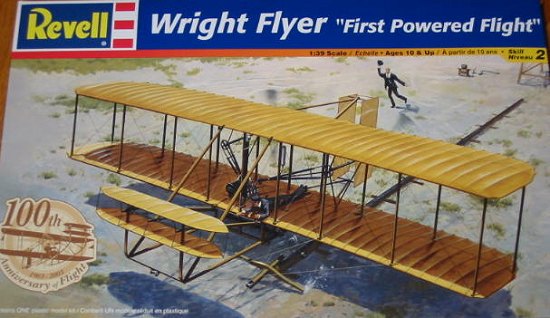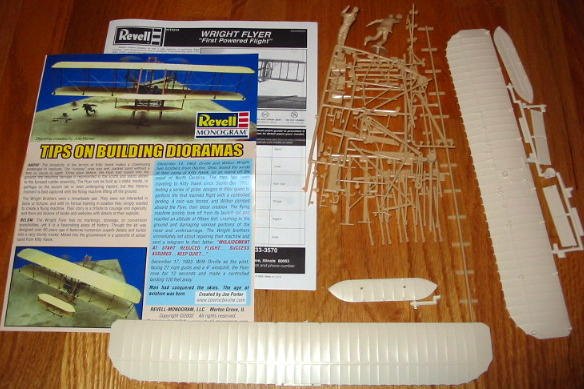
|
KIT: |
Revell 1/39 Wright Flyer |
|
KIT # |
5243 |
|
PRICE: |
$10.80 |
|
DECALS: |
None |
|
REVIEWER: |
Bill Michaels |
|
NOTES: |
Reissue of Monogram kit with some extra diorama goodies. |

|
HISTORY |
In this, the 100th anniversary year of the Wright Brothers first flight, there’s probably not much need for a history section in this preview……! So, on to the model.
|
THE KIT |

This is a re-release of the old Monogram 1/39 scale kit of the Wright Brothers’ first Flyer. I built the old Monogram kit back in the mid 1970’s—this kit looks just like the one I remember. This release of the kit has a copyright of 2003 on the box, and a “100th Anniversary” logo.
The kit includes the same parts as the old Monogram kit, including the extras for the first flight diorama. The launching rail, miscellaneous support equipment, and a running figure of Wilbur Wright are all included. Also included is a clear plastic stand so the model can be positioned in flight over the end of the launching rail. A nice addition is a spool of silver-grey thread for rigging the model. (I don’t recall if the old kit had the thread or not.)
According to the diorama insert in the box, the kit was designed 40 years ago. As a 1960s-vintage product, the kit is similar in many regards to other kits of the era. There are some ejector pin marks that will need to be filled.
The “cockpit” consists of a prone Orville Wright figure, and the rudimentary controls of the prototype. A simple engine, fuel tank, and chain drive complete the central area of the wing.
The kit consists of about 50 parts, molded in two colors. The flying surfaces are molded in a creamy color. The rest of the parts are molded in tan plastic. (My old kit used dark brown for these parts IIRC.) A nice touch is that the different color parts are packed in separate bags, so they won’t rattle around. Another nice touch is the way the parts fit diagonally in the box, so they can’t slide around.
There is a not a lot of surface detail to represent. The ribs are raised, and may be a little overdone. There is some stitching detail on the wings, where the different panels of linen were joined. My kit had very clean molded parts. There is virtually no flash, and no signs of mold misalignment.
The wings are molded in one piece, with pronounced ribs and nice thin trailing edges. The problem with the one piece wing is a series of ejector pin marks on each wing, with about a dozen on each part. These marks are on the top surface of the bottom wing, and on the underside of the top wing. The ones on the bottom wing will probably have to be filled, though you may get away with ignoring the ones on the underside of the top wing.
This kit looks like it was designed for the North American market. Most of the instructions are in English only, with the exception of the obligatory warnings, which are also in French. Generic colors are called for in the painting notes, but then again we don’t need FS numbers here! Flat black, white, red, steel, and silver are the only colors called for. The parts are all identified by name, too, which is another nice touch. The paper itself is the heavier bond type, and not the cheap newsprint type of paper.
Throughout assembly, rigging and painting instructions are given. Rigging the model is done as you go along. Each piece of thread is called out with a length (in inches), which is handy. One odd thing about the instructions is that they do not mention the launching track at all.
A nice addition to this kit is a 4 page, glossy color insert about creating a diorama of the first flight, by Joe Porter. There is nothing on the box to indicate this was in there—it was a pleasant surprise. I really have to give Revell a lot of credit for this—it has a lot of good tips on ways to improve the model.
The first page of the insert gives an expanded history of the Wrights and the aircraft. The two inside page has 22 specific steps of how the aircraft was assembled and improved for the diorama. Ways to improve detail parts and add extra detail are described. The last page of the insert describes the construction of the diorama base.
|
CONCLUSIONS |
Highly Recommended. I really got a positive feeling from this kit. It seems as if Revell really tried to do a good job on this re-release. The packaging, the completeness of the instruction sheet, and the extra diorama insert all made positive impressions. (Given that the only competition is a tiny Glencoe kit and the expensive Hasegawa 1/8 kit, they could have gotten away without trying so hard.)
I have to give Revell a lot of credit for releasing this kit this year, and for going the extra mile to include the useful diorama sheet to show how, with a little extra effort, this 40 year old kit can be improved. Given that the price is so reasonable, I expect they’ll sell a lot of these. I can’t help but think that Revell is making an effort to impress buyers that might not be regular modelers-- there is definitely some potential here for use in school projects! I hope this release sells well- it deserves to be successful.
Review kit courtesy of my wallet.
If you’re interested in finding what US Coast Guard subjects are available as models, check out my list of USCG Model Kits at:
If you would like your product reviewed fairly and quickly by a site that has nearly 200,000 visitors a month, please contact me or see other details in the Note to Contributors.